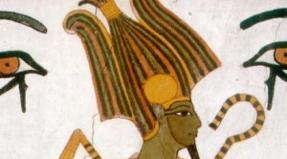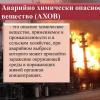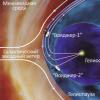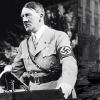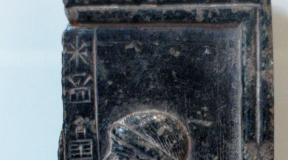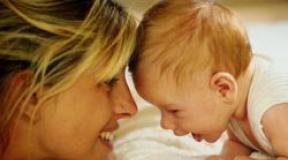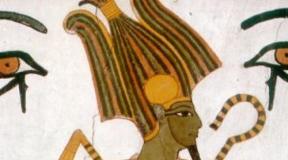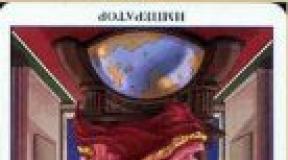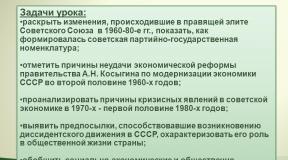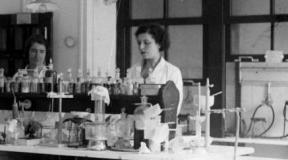Speech therapy lesson in the preparatory group - action words. Speech therapy lesson on speech development (preparatory group for school) lesson notes, polysemantic words (polysemantic words with the meaning of action). Development of auditory memory
Mavlyutova Eleonora Vinorisovna,
teacher-speech therapist MADOU d/s No. 133, Tyumen
Educational:
Practical learning by children of words denoting actions
Forming the ability of children to ask questions about words and answer them.
Corrective:
Development of general, fine, articulatory motor skills, facial expressions, voice,
Development of phonemic hearing,
Development of attention, memory, thinking.
Educational:
Cultivating interest in the activity,
Developing self-control over your speech,
EQUIPMENT: story pictures, signal cards, pictures with animals, chest.
1. Organizational moment.
Today in class we will show and name many different actions, movements, ask questions and answer them
Smile at each other and say:
We will study, we will try.
Give correct answers and help each other!
2. Psycho-gymnastics.
Draw an affectionate kitten asking for milk. Show the disappointment of a little chicken who wanted to crow like a rooster, but nothing worked out for him, they will ask you to pretend to be cheerful.
3. Speech therapy gymnastics.
Lip charger. "SMILE"
Our lips smiled
Very, very stretched.
"SMILE-TUBE"
A smile and a pipe.
They stretched out into a pipe.
Tongue charger.
4. Development of phonemic hearing.
I will pronounce words correctly and incorrectly, and you clap your hands only when you hear the correctly spoken word:
(bunny, dyka, plover, yezik, hedgehog, yuzik, cat, kitten, kitten..)
5. Work on the topic.
What is the cow doing? -Moos
What is the horse doing? -Laughs
What is the cat doing? -Meows
What is the dog doing? -Barks
What is the goose doing? -Cackles
What is the duck doing? -Quacks
What is the chicken doing? -Cackles
Speech therapist: - Children, you named a lot of different words. To these words you can ask the question “What does it do?” All these words mean different actions. We will call them action words.
Speech therapist: We just remembered what sounds animals can make. And in the pictures that are in front of you, the animals perform various actions. Name these actions. Children each look at their own picture and answer in one word the question “What is it doing?”
(Sleeps, jumps, runs, barks, jumps..)
Looking at story pictures
The rooster is standing. The word action is worth.
The kitten laps milk. The word action is lapping.
The bunny gnaws a carrot. The word action is gnawing.
A cow grazes in a meadow. Words action - grazing.
6. Physical education minute.
A bear is walking through the forest,
This bear is looking for honey.
He is hungry and sad.
Where do forest bees live? (Walk in place.)
It will turn right
Then he looks to the left.
Where is the swarm of bees hovering here?
Who's buzzing among the bushes? (Turns right and left.)
7. Consolidation of the material covered.
Listen to a couple of sentences. Every second sentence contains a missing word - action. Your task is to guess which word is missing.
The cat catches the mouse. A mouse from a cat... (runs away)
The dog barks at the cat. Cat from dog... (saves, escapes)
The fox went hunting. The fox prey…. (caught)
The bear fell from the tree. The bear from the tree... (fell, fell)
Guys, now for a new task: listen to the sentences and from each name only the word denoting the action and “put” the word in the chest.
The little hare eats bark. The bear loves honey. The wolf caught the prey. The dog guards the house.
Summary of the lesson.
Speech therapist: - Children, today in class you performed different actions, named action words, learned to ask questions about words (What does it do?)
The speech therapist evaluates the children's work and encourages them.
Literature.
1. Zhukova, N. S. Speech therapy: overcoming general speech underdevelopment
for preschoolers: book. for speech therapist / N. S. Zhukova, E. M. Mastyukova, T. B.
Filicheva. – Ekaterinburg: LITURE, 2005
2. Agranovich 3.E. A collection of homework to help speech therapists and parents to overcome lexical and grammatical speech underdevelopment in preschoolers with SLD “Childhood-Press”, 2003
3. Formation of lexical and grammatical representations / Tkachenko T. A. - St. Petersburg: Childhood, 1998
We invite preschool teachers of the Tyumen region, Yamal-Nenets Autonomous Okrug and Khanty-Mansi Autonomous Okrug-Yugra to publish their teaching material:
- Pedagogical experience, original programs, teaching aids, presentations for classes, electronic games;
- Personally developed notes and scenarios of educational activities, projects, master classes (including videos), forms of work with families and teachers.
Why is it profitable to publish with us?
Summary of speech therapy classes for the senior group.
Topic: Action words. Animals
GOALS:
Educational:
Practical learning by children of words denoting actions
Forming the ability of children to ask questions about words and answer them.
Corrective:
Development of general, fine, articulatory motor skills, facial expressions, voice,
Development of phonemic hearing,
Development of attention, memory, thinking.
Educational:
Cultivating interest in the activity,
Developing self-control over your speech,
EQUIPMENT: story pictures, signal cards, pictures with animals, chest.
1. Organizational moment.
Today in class we will show and name many different actions, movements, ask questions and answer them
Smile at each other and say:
We will study, we will try.
Give correct answers and help each other!
2. Psycho-gymnastics.
Draw an affectionate kitten asking for milk. Show the disappointment of a little chicken who wanted to crow like a rooster, but nothing worked out for him, they will ask you to pretend to be cheerful.
3. Speech therapy gymnastics.
Lip charger. "SMILE"
Our lips smiled
Very, very stretched.
"SMILE-TUBE"
A smile and a pipe.
They stretched out into a pipe.
Tongue charger.
4. Development of phonemic hearing.
I will pronounce words correctly and incorrectly, and you clap your hands only when you hear the correctly spoken word:
(bunny, dyka, plover, yezik, hedgehog, yuzik, cat, kitten, kitten..)
5. Work on the topic.
The game “Who votes in what way?”
What is the cow doing? -Moos
What is the horse doing? -Laughs
What is the cat doing? -Meows
What is the dog doing? -Barks
What is the goose doing? -Cackles
What is the duck doing? -Quacks
What is the chicken doing? -Cackles
Speech therapist: - Children, you named a lot of different words. To these words you can ask the question “What does it do?” All these words mean different actions. We will call themaction words.
Speech therapist: We just remembered what sounds animals can make. And in the pictures that are in front of you, the animals perform various actions. Name these actions. Children each look at their own picture and answer in one word the question “What is it doing?”
(Sleeps, jumps, runs, barks, jumps..)
Looking at story pictures
The rooster is standing. The word action is worth.
The kitten laps milk. The word action is lapping.
The bunny gnaws a carrot. The word action is gnawing.
A cow grazes in a meadow. Words action - grazing.
6. Physical education minute.
A bear is walking through the forest,
This bear is looking for honey.
He is hungry and sad.
Where do forest bees live? (Walk in place.)
It will turn right
Then he looks to the left.
Where is the swarm of bees hovering here?
Who's buzzing among the bushes? (Turns right and left.)
7. Consolidation of the material covered.
Listen to a couple of sentences. Every second sentence contains a missing word - action. Your task is to guess which word is missing.
The cat catches the mouse. A mouse from a cat... (runs away)
The dog barks at the cat. Cat from dog... (saves, escapes)
The fox went hunting. The fox prey…. (caught)
The bear fell from the tree. The bear from the tree... (fell, fell)
Guys, now for a new task: listen to the sentences and from each name only the word denoting the action and “put” the word in the chest.
little hareeats bark Bearloves honey. Wolfcaught prey. Dogguards house.
Summary of the lesson.
Speech therapist: - Children, today in class you performed different actions, named action words, learned to ask questions about words (What does it do?)
The speech therapist evaluates the children's work and encourages them.
Summary of frontal speech therapist session
with a group of 1st grade students (ONR Shur.)
Lesson topic : “Words denoting the action of an object.”
Purpose of the lesson:
Tasks:
Development of the ability to identify words denoting the action of an object, based on its lexical and grammatical meaning.
Development of the ability to ask a question to an action word.
Graphic designation of action words.
Differentiation of words-objects and words-actions.
Enrichment of the verbal dictionary due to the formation of verbs from onomatopoeic words.
Development of motor skills.
Development of visual, auditory attention, selective inhibition.
Speech development.
Development of attention, memory, thinking.
Expanding and improving students' vocabulary.
Development of visual perception and attention.
Formation of the ability to accept a learning task.
Formation of adequate self-esteem.
Equipment:
music Center;
disc “Sounds of Nature”;
printed copybooks;
prizes.
Progress of the lesson:
"Kwa-kwa-kwa" yes "r wa-kwa-kwa"?
Jumper-coward,
The tail is short,
Eyes with a braid,
Ears along the back
Fur coat in two colors -
For winter and summer.
Who clicks his teeth and clicks?
Wandering near the village...
Lives in a hole
Gnawing on crusts.
small legs,
He is very afraid of cats.
Who, having forgotten worries,
Sleeps in a den in winter?
2). Name all the guess words.
3). What do these words mean?
Which subjects?
What question do these words answer?
4). What fairy tale are these animals from? Mouse-Norushka, Frog-Frog, Bunny-Run, Wolf-Teeth Click and Bear?
Children say hello.
FROG
HARE
WOLF
MOUSE
BEAR
Children remember and name guess words.
Items.
Alive.
Who?
"Teremok"
II . Main part
Activation of the dictionary, clarification, enrichment of the dictionary.
Activation of the dictionary, clarification, enrichment of the dictionary. Formation of verbs from onomatopoeias.
Development of visual functions. Development of logical thinking.
Development of visual functions, attention, observation.
Today we will compose a new fairy tale in which the Bear will not break our little house. In our fairy tale, the Bear is a teacher. He is wise, smart. He will give tasks to the animals, and we will help them complete them.
Task 1.Who moves how?
frog (what is he doing?) - …….
mouse (what is it doing?) - ...
hare (what is he doing?) - ...
wolf (what is he doing?) - ...
bear (what is he doing?) - ….
frog (what is he doing?) - …….
mouse (what is it doing?) - ...
hare (what is he doing?) - ...
wolf (what is he doing?) - ...
bear (what is he doing?) - ….
What words did we use? What do our words mean?
What question did the words answer?
What are we going to talk about today, what words?
Task 3. Game “The most attentive”
It is very important for children to be obedient and obey their elders. Otherwise, various troubles will happen to them. Look at the picture, which animal ran away from its place? Give it back.
Task 4. Graphic dictation.
Remember how words and objects are designated?
Remember how words and actions are designated?
Write down the words graphically:
squirrel, jumping, searching, howling, wolf, badger, digging, swimming, mole.
Let's check again; How many action words did you get?
Task 5. Game “Hide and Seek”.

Friends sent the bear fromAfrica photograph.
Find in the picture, color and name the animals hidden in the jungle.
jumps, swims, gallops
runs
jumps, runs, gallops
runs, prowls walks
walks, staggers, runs
croaks
beeps
howls, growls
growls
Actions.
What is he doing?
About words-actions.
Children look at the picture and find a pattern; connect the “naughty” (squirrel)
animal line with an empty cell. Explain the answer.
One line.
Two lines.
They draw diagrams.
Children name animals and birds: elephant, rhinoceros, tiger, crocodile, giraffe, zebra, monkey, cobra, parrot.
III . Physical education minute
Development of visual and auditory attention, selective inhibition.
Game "Do what I show."
Game "Do what I say."
or
Girls and boys
They jump like bunnies
How frogs jump
They never cry.
Like foxes wagging their tails,
They are catching up with the gray mice.
We straightened up, stretched,
One bent over, two bent over
And they smiled at each other.
Perform various movements.
Perform movements according to the text of the poem.
II . Main part (continued)
Activation of the dictionary, development of the ability to ask a question about an action word, formation of semantic fields.
Expansion and enrichment of the dictionary due to the formation of verbs from onomatopoeia-
telny words.
Development of auditory perception, sense of rhythm, rhyme.
Development of auditory attention and memory.
Task 6. What do objects do?
1). Name the actions that are encrypted.
2). What can each item do? Connect the object with the action symbol with a colored line, asking a question about the word.
Task 7. Compose a poem.

We completed all of Bear's tasks. The bear is happy. He went into the thicket to his den, and left us a bag of gifts.
Standing, walking, sitting, running, jumping, riding (rolling), swimming, lying (sleeping).
For example:
the ball (what does it do?) – jumps, rolls, floats, flies, lies.
Form verbs
According to the picture plan, they remember and recite the poem.
IV . Result, reflection, self-esteem.
Development of logical thinking, formation of self-esteem of memory
Let's remember what words we talked about? What question were they answering?
What did we do today?
What did you like about the lesson?
How did you do today? (What worked? Didn’t work? Why? Could we have worked better? What is needed for this?)
Choose a sun and color it.
Thank you all very much. Goodbye.
PRIZES
About words and actions.
What is he doing?
List of types of work.
They reflect.
They choose the “sun” and color it.
Goodbye.
Self-analysis of the frontal lesson
teacher-speech therapist Natalia Vladimirovna Chernetskaya
The lesson was conducted with a group of 1st grade students, consisting of 4 people, who had a speech therapy conclusion: general speech underdevelopment of level III.
Lesson topic: “Words denoting the action of an object.”
Purpose of the lesson: Working on the word. Formation of the concept of words denoting the action of an object.
There is complexity in the formulationtasks:
educational (1-3, 5);
correctional (4, 6-12);
educational (13-15).
The structure of the lesson corresponds to speech therapy information requirements (organizational moment, work on the material covered, the main part, physical education, summing up, reflection, self-assessment. The parts of the lesson are logically interconnected.
The tasks and speech material corresponded to the topic, purpose of the lesson, age of the children and speech therapy conclusion.
Used during the lessonequipment :
didactic manual “Plot for the lesson (“Teremok”)”;
magnetic pictures “Animals” (mouse, frog, wolf, hare, bear);
music Center;
disc “Sounds of Nature”;
printed copybooks;
The following were suggested during the lesson:educational games:
“Guess the riddles” (development of auditory attention, activation of vocabulary, development of logical thinking);
“The most attentive” (development of visual functions, development of logical thinking);
“Hide and seek” (development of visual functions, attention, observation).
“Composing a poem” (expanding and enriching the vocabulary by forming verbs from onomatopoeic words, developing auditory perception, sense of rhythm, rhyme, developing auditory attention, memory).
Used developmental exercises :
“Who moves how?” (development of word-formation processes, activation, clarification and enrichment of the dictionary);
“Graphic dictation” (development of auditory perception, development of logical thinking, differentiation of words-objects and words-actions).
“What do objects do?” (lexical compatibility of words, formation of the ability to ask a question about an action word).
During the lesson, a differentiated approach was carried out; frontal work was combined with individual work.
The mental activity of the children was constantly intensified. All forms of speech activity were practiced: listening, speaking, writing, reading.
The following methods were used to maintain interest and attention:
all exercises were of a playful nature;
activities changed frequently;
visualization was used;
oral work was combined with written work.
The lesson was conducted at the right pace, corresponding to the capabilities of this group of children.
During the lesson, a physical exercise was held. The exercises were aimed at developing general motor skills, relieving fatigue, as well as developing visual and auditory perception, attention, and selective inhibition.
The lesson was structured taking into account the principle of development: the tasks became more complex and required overcoming difficulties. Work was carried out to fill gaps in speech development, work to enrich the vocabulary, and develop the grammatical structure of speech.
The following were also implementedprinciples:
accessibility: tasks and exercises corresponded to the level of knowledge and skills achieved;
Consciousness: children completed tasks consciously;
the principle of relying on safe links: safe analyzers were used to secure images.
During the lesson, music therapy was used (musical accompaniment of the pedagogical process), thereby creating a positive emotional background in the lesson and providing mild brain stimulation.
The following were used in the lesson:technologies:
correctional and developmental
developing
health-saving
gaming
The lesson was conducted in a friendly tone. During the lesson, the speech therapist monitored his own speech and the speech of the child, corrected mistakes, forced him to correctly repeat words in which mistakes were made, and sought a complete answer to the question.
The speech therapist teacher is prepared for the lesson, has an outline, and has prepared the visuals in advance.
The teacher-speech therapist has a friendly attitude towards children, “feels” the class, knows how to interest children and maintain discipline during the lesson.
At the end of the lesson, the results were summed up: the children remembered what they did in the lesson, what they learned, remembered, and evaluated their work in the lesson.
During the lesson, all the assigned tasks were solved, the goal was achieved.
Developedteacher speech therapist:
Shishmakova Marina Anatolyevna
MA preschool educational institution "Kindergarten No. 203", Perm
Goals:
1) Develop the ability to accurately use words denoting the actions of objects.
2) Qualitative and quantitative growth of the vocabulary.
3) Exercise students in morphological analysis and synthesis of words.
4) Expansion of the dictionary through synonyms and antonyms.
Progress of the lesson.
1. Organizational moment.
It doesn’t go and doesn’t go,
Because it's icy!
But it falls perfectly,
Why isn't anyone happy?
(education of expressive speech and clear whispered speech)
Speech therapist - Name the words that denote the actions of objects.
Children - Writes, reads, draws, etc.
Speech therapist - Repeat after me only the words denoting actions:
Barks, croaks, crawls. He cooks, saws, squats.
Blows, jumps, walks. Jumps, cowers, flies.
She sews and plays the pipe. Beats, caresses, twists, sleeps.
Whitewashes with a brush, sweeps. And he sits at his desk.
Speech therapist - What do the words you repeated after me mean?
Children - Actions.
2. Subject message.
Speech therapist - Today we are working on the topic: “Words denoting the actions of objects.”
Speech therapist - I offer pictures-objects and pictures-actions:
Grandma Grandma is knitting.
Car The car is moving.
Boy The boy is reading.
Girl Girl jumping.
Children name the word - object and the word action, ask questions: what does it do?
A speech therapist with children comes to the conclusion: words that answer the questions what does it do? what are they doing? indicate the actions of objects.
3. Exercises in recognizing words that answer the question what does it do?
Exercise.
To the words answering the questions who? What? choose words that answer the question what does it do?
Bear (sneaks through, walks)
Tit (sings, flies)
The car (drives, rushes)
Girl (plays, draws)
The sun (shines, warms)
Add:
Mother mends, darns, sews (who?).
The teacher reads, tells, explains.
The grandmother cooks, cooks, bakes (who?).
Guess who it is? or what is it?
The dog is guarding, gnawing, barking.
The cat meows, purrs, laps (who?).
A bee flies, buzzes, stings (who?).
Physical exercise.
Swing, spin,
Stretch, straighten up,
Squat, squat,
Walk, walk,
Take a deep breath now,
Sit quietly and relax.
Put everything in order,
And start writing, friends!
4. Certificate.
Working with isographs. Guessing puzzles.
Exercise.
Add the missing letter: the chair fell
The girl fell...
The tree fell...
Insert appropriate words denoting the actions of objects:
1) Petya Ivanov on duty... flowers.
2) My dad... at the factory.
3) In the park I... a hare.
Exercise.
Match these words with words of the same root that answer the question: what does it do? (ball game)
Drawing - draws Gift - gives
Cheerful - cheerful Frost - freezing
Watchman - guards Game - plays
Match these words with words that are similar in meaning:
Laugh - (laugh)
Throw - (throw)
Work - (work)
Choose words that have opposite meanings:
Stand - (walk) Say hello - (say goodbye)
Silence - (speak) Raise - (lower)
5. Working with proverbs.
Explain the meaning of the proverbs:
- Who does not work shall not eat
- Don't be quick with your words, be quick with your actions.
Children explain the meaning of proverbs.
6. Work on the text.
Divide the text into sentences(mark the boundaries of the sentences).
Text 1.
Swallows were flying high above the river, they were playing tag, suddenly a falcon flew in with sharp wings and the swallows whistled and instantly flew away.
Find words denoting the actions of objects, underline them with two lines.
Text 2.
There was a house in the forest, three bears lived in it, one was called Mikhail Ivanovich, he was big and shaggy, the other was a bear, her name was Nastasya Petrovna, and the little bear cub was called Mishutka.
Mark the boundaries of the sentences. Continue the story orally.
7. Summary of the lesson.
Speech therapist - What topic were you working on?
What did you remember?
What did you like most?
Summary of a speech therapy lesson in the senior group for children with speech disorders
TOPIC: Words denoting the actions of objects.
GOALS:
Educational:
Practical learning by children of words denoting actions
Forming the ability of children to ask questions about words and answer them.
Corrective:
Development of general, fine, articulatory motor skills, facial expressions, voice,
Development of phonemic hearing,
Development of attention, memory, thinking.
Educational:
Cultivating interest in the activity,
Developing self-control over your speech,
Cultivating a friendly attitude towards each other.
EQUIPMENT: story pictures, signal cards, pencils, sheet of paper, “magic bag”, toys, ball.
PROGRESS OF THE CLASS:
1. Organizational moment.
Today in class we will show and name many different actions, movements, ask questions and answer them.
Smile at each other and say:
We will study, we will try.
Give correct answers and help each other!
2. Speech therapy gymnastics.
We raise our hands up and then lower them,
and then we’ll separate them and quickly pull them closer to us.
We raise our eyebrows up and then lower them.
We puffed out our cheeks, we sucked in our cheeks.
We were surprised, we smiled, we got fat, we lost weight,
They sat down quietly.
We massage the fingers (we call each finger).
Facial massage (we call parts of the face).
Exercises for the lips (A-O-U-I - “we say” without a voice, in a high voice - “fox song”, in a low voice - “bear song”)
Tongue charger.
3. Development of phonemic hearing.
Toys on display include a doll, a train and a hammer. How does a doll cry? (Ah-ah-ah.) What did we say? (Sound.) How does the train whistle? (Uh-uh.) Is it a sound or a word? (Sound.) How does the hammer knock? (D-d-d. This is also a sound.) Name the words - the names of the toys.
Sticks are placed on the board to represent each word spoken.
We named a lot... (words).
Stripes are displayed - symbols of words.
Look at the stripes, these are houses of words. We will denote words with these stripes. Do you remember what words are made of? (From sounds.) Make a cup with your hands, collect the sounds and say the word.
The speech therapist pronounces the words slowly, in a whisper, and the children speak loudly and in unison.
Kuuklaa, mmyachiik... (doll, ball). How do we designate sounds? (In circles.)
Open your pencil cases, take a red circle in your right hand, and a strip like this in your left hand. What do we mean by this stripe? (Words.) If I say a word, raise the bar, and if you hear a sound, raise the circle.
The speech therapist pronounces vowel sounds and words, and the children show the corresponding symbol.
4. Work on the topic.
The speech therapist gives the children the following task:
Nastya, draw!
Children, tell me in one word, what is Nastya doing?
Children: - Draws.
Speech therapist: - Artem, jump on one leg!
Children, tell me in one word, what is Artem doing?
Children: - Jumping.
Speech therapist: - Vika, throw me a ball!
What is Vika doing?
Children: - Throws it away.
Speech therapist: - Roma, clap your hands!
What is Roma doing?
Children: - Claps.
Speech therapist: - Children, you named a lot of different words. To these words you can ask the question “What does it do?” All these words mean different actions. We will call them action words.
The speech therapist names action words, and the children ask these words the question “What does it do?”
He cooks, sews, barks, sleeps, swims, writes, laughs.
5. Physical education
Game “We won’t tell you where we were, but we’ll show you what we did.”
6. Practical mastery of singular and plural verbs.
Speech therapist: What did we do? (Danced, washed, cleaned, swam.)
We called action words.
7. Fixing the material.
Game "Who does what?"
Speech therapist: - Children, look at each of your pictures and answer in one word the question “What is he doing?”
Children take turns naming action words: knitting, cooking, running, barking, washing, reading.
Speech therapist: - Children, what question can you ask about words-actions?
Children: - What does he do?
Game "Magic Bag".
Speech therapist: - Children, take one object out of the magic bag and tell me in one word what it can do?
Children take out toys: a car, a ball, a bell, an airplane, a hedgehog, a teddy bear, and name action words: rides, jumps, rings, flies, pricks, growls.
8. Summary of the lesson.
Speech therapist: - What did we talk about in class today? What did you like most?
Now we will stand in a circle, hold hands, smile at each other and say: Thank you for your good work.
Read also...
- Falsification of world history as an attempt to change the modern world order
- “Not a step back”: how Stalin’s order influenced the course of the Great Patriotic War
- Brusilov breakthrough: briefly about the offensive
- Marduk Vaal Marduk god of Abraham's homeland Babylon Akkad Sumer interfluve religion Supreme god and patron of Babylon


